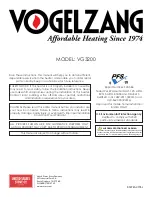
Creosote
1. moisture to form creosote. The creosote vapours condense in the relatively cool chimney flue of a slow
burning fire. As a result, creosote residue accumulates on the flue lining. When ignited, this creosote
makes an extremely hot fire. The chimney connector and chimney should be inspected periodically (at
least once every two months) during the heating season to determine if a creosote buildup has occurred.
If creosote has accumulated (3 mm. or more), it should be removed to reduce the risk of a chimney fire.
1. Highest smoke densities and emissions occur when a large amount of wood is added to a bed of hot
coals and the air inlet is closed. The heated wood generates smoke, but without ample air, the smoke
cannot burn. Smoke-free, clean burning requires small fuel loads, two or three logs at a time or 1/4 to 1/2
of fuel load and leaving the air inlet relatively wide open, especially during the first 10 to 30 minutes after
each loading, when most of the smoke generating reactions are occurring. After 30 minutes or so, the air
inlet can be turned down substantially without excessive smoke generation. Wood coals create very little
creosote-producing smoke.
2. The cooler the surface over which the wood smoke is passing, the more creosote will be condensed. Wet
or green wood contributes significantly to creosote formation as the excess moisture that is boiled off
cools the fire, making it difficult for the tars and gases to ignite, thus creating dense smoke and poor com-
bustion. This moisture-laden smoke cools the chimney, compounding the problem by offering the smoke
the ideal place to condense.
In summary, a certain amount of creosote is inevitable and must be lived with. Regular inspection and clean-
ing is the solution. The use of dry, seasoned wood and ample combustion air will help to minimize annoying
smoke emissions and creosote buildup.
Chimney Fires
The result of excessive creosote buildup is a chimney fire. Chimney fires are dangerous. Chimney inside
temperatures can exceed 2000°F(1100˚C). This causes much higher than normal temperatures in the chimney
and on its exterior surfaces. Thus ignition of nearby or touching combustible material is more likely during a
chimney fire. Proper clearances are critical during such a fire.
Formation and need for removal
8. If gold door requires cleaning, use mild soap and water only. Use of abrasive cleaners will void warranty.
9. Establish a routine for the fuel, woodburning and firing technique. Check daily for creosote buildup until
experience shows how often you need to clean to be safe.
10. Be aware that the hotter the fire, the less creosote is deposited. Weekly cleaning may be necessary in mild
weather, even though monthly cleaning is usually enough in the coldest months when burning rates are
higher.
11. Instruct all members of your family on the safe operation of the heater. Ensure they have enough knowl-
edge of the entire system if they are expected to operate it. Stress the section on chimney fires and the
importance of following the steps outlined "In Case of Chimney Fire".
When wood is burned slowly, it produces tar and other organic vapours, which combine with expelled
SUPER-SD1_100517-32
5
5055.201
Содержание Classic Gas
Страница 31: ...SUPER SD1_100517 32 31 5055 201...






































